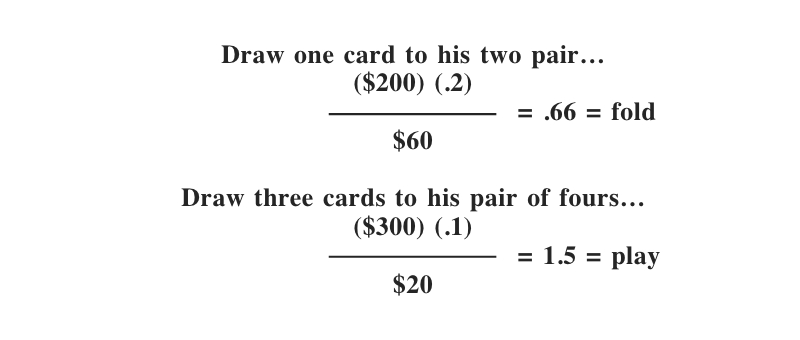Investment Odds
2. Investment Odds
Investment odds are the estimated returns on money that is bet. These odds are approximated by the following formula:

Note: If you are a beginner or are not mathematically inclined, do not be discouraged or get bogged down by this formula. Forget the formula for now and read on. With experience, you will realize that accurate estimations of investment odds are achieved by the proper thinking methods and not by mathematical problem-solving. This formula is merely a shorthand expression of the thought process required for properly evaluating a bet.
For example, if a player estimates that a $80 potential pot would require a $20 betting investment (his potential loss), and if he estimates that his probability of winning that pot is .4 (40 percent7) then his investment odds would be calculated as follows:

When the investment odds are greater than 1.0, the play is favorable and should be made.
Investment odds are important for making correct betting and playing decisions. Most players rely only on card odds, which often lead to wrong decisions. For example, investment odds sometimes favor drawing to an inside straight. At other times, investment odds favor folding three aces before the draw. In both cases, the wrong play may result if the decision is based on the card odds.
_______________________
7 How does a player estimate the probability of winning a pot? He does this by assessing his own hand and position against the behavior and betting of his opponents. Initially, the estimates may be little more than guesses. Accuracy will improve with practice, experience, integrated effort, and application of various concepts described in this course.
Determination of investment odds is not a mathematical problem. Numbers plugged into the investment-odds formula are quick estimations or guesses derived by gathering together and then objectively evaluating the facts of the game, players, and situation. Those estimations become more valid with increased thinking effort and experience. While the good player may never actually use or even think about the investment-odds formula, it does express his thought process for evaluating bets.
Quintin, Ted, and Scotty each draw one card. John Finn holds two low pair, tens and fours. What does he do? He considers the card odds, the past betting, probable future betting, his observations (e.g., of flashed cards), and his reading of each opponent… and then estimates the following investment odds:

So instead of folding his two pair (and often the investment odds favor folding the two small pair), he breaks up his hand and draws to the pair of fours at favorable investment odds. The low $20 estimate of his potential loss is the key to making this play favorable. John figures his chances for catching and having to call the last bet are small.8 small—even though the last-round bet may be large if he improves his hand. In other words, he will fold with no additional cost unless he catches three of a kind or better, which would let him bet heavily with a good possibility of winning.
_______________________
8 The weakness of hands such as small pairs, four flushes, and four- card straights after the draw increases the investment odds because failure to improve those hands causes an immediate fold, thereby reducing the potential loss.
In another hand, Sid and Ted draw three cards. Again John has two low pair. After objectively weighing all factors within the framework of the investment-odds formula, he estimates his most favorable play is to stay pat and then bet the last round as if he had a straight or a flush:

The advantages of this play are: If either Sid or Ted catches two pair or even trips, he may fold and let John win on a pat bluff. If either catches a strong hand and shows any betting strength, John folds with no additional cost. Also, neither will try to bluff into John’s pat hand. And finally, if Sid and Ted do not improve, John Finn wins additional money if either one calls.
John Finn is the only good player in the Monday night game. He works hard, thinks objectively, and adapts to any situation. By applying the Advanced Concepts of Poker, he wins maximum money from the game.
To overcome mental laziness and restrictive thinking, he forces himself to think constantly and imaginatively about the game. That effort lets him make more profitable plays. For example, he breaks up a pat full house9 to triple the size of the pot while decreasing his chances of winning only slightly (from 98 percent down to 85 percent). But that play increases his estimated investment odds from:

_______________________
9 The opportunity to profitably break a full house by drawing to three of a kind rarely occurs. The above case results when several players with weak hands would fold if the full house were played pat, but would call if a draw were made. Also, the full house would be broken to draw to four of a kind if sufficient evidence existed that the full house was not the best hand.
John wins consistently, but still his opponents refuse to realize that they are paying him thousands of dollars every year to play in their game.